Why this resume works
- Highlights industry-specific skills: The applicant tailors their resume for the entertainment industry by including roles like costume designer and wardrobe supervisor, and emphasizing specialized skills in budget management, creative collaboration, and fabric sourcing.
- Quantifies accomplishments: Measurable accomplishments like designing costumes for over 20 productions annually and managing $100,000 budgets per show reflect tangible impact and success.
- Showcases career progression: Progressing from costume assistant to costume designer showcases growth through increased leadership responsibilities, larger-scale projects, and creative autonomy over high-profile productions.
More Costume Designer Resume Examples
Browse more costume designer resume examples to discover how to spotlight your creativity, craftsmanship, and design projects. These entertainment resume samples will guide you in crafting a resume that captures your unique style and experience.
Entry-Level Costume Designer
Why this resume works
- Effective use of keywords: Integrating industry-specific keywords like “creative costume design” and “budget management,” the applicant aligns their experience with ATS requirements, improving their visibility to potential employers.
- Puts skills at the forefront: The skills-based resume format spotlights abilities like fashion trend analysis and project management, ideal for those entering the field.
- Shows digital literacy: Emphasizing computer skills such as efficiency in budget management through digital tools showcases readiness for tech-driven environments.
Mid-Level Costume Designer
Why this resume works
- Includes a mix of soft and hard skills: Integrating technical skills like budget management with interpersonal skills such as team collaboration, the applicant effectively balances creative and analytical strengths in diverse settings.
- Demonstrates language abilities: Possessing language skills in Spanish, French, and Italian enriches the applicant’s ability to navigate cross-cultural interactions in international film and theater projects.
- Points to measurable outcomes: Managing a $50K costume budget while reducing costs by 10% highlights an impressive ability to achieve measurable financial outcomes efficiently.
Experienced Costume Designer
Why this resume works
- Focuses on work history: By using a chronological resume format, the applicant clearly outlines their extensive work history, showcasing growth from assistant costume director to a seasoned designer.
- Showcases impressive accomplishments: The applicant includes standout accomplishments like increasing efficiency by 30% and winning best costume design, demonstrating significant impact and senior-level performance.
- Lists relevant certifications: Highlighting certifications such as certified professional costume designer emphasizes the applicant’s expertise and dedication to advancing their craft.
Costume Designer Resume Template (Text Version)
Olivia Martinez
Buffalo, NY 14201
(555)555-5555
Olivia.Martinez@example.com
Skills
- Costume Design
- Budget Management
- Team Leadership
- Fabric Sourcing
- Sewing and Alterations
- Vendor Coordination
- Creative Collaboration
- Project Management
Languages
- Spanish – Beginner (A1)
- French – Intermediate (B1)
- Italian – Beginner (A1)
Professional Summary
Accomplished costume designer with 7 years of experience. Expertise in budget management, team leadership, and creative collaboration for productions. Proven track record of enhancing efficiency and delivering high-quality designs.
Work History
Costume Designer
Hollywood Couture – Buffalo, NY
July 2022 – July 2025
- Designed costumes for 20+ productions annually
- Managed a budget of 0,000 per show
- Collaborated with directors to achieve vision
Wardrobe Supervisor
Starry Night Productions – Albany, NY
July 2018 – June 2022
- Oversaw costume fittings and alterations
- Led a team of 10 costume assistants
- Coordinated with vendors for custom pieces
Costume Assistant
Broadway Styles Inc. – New York, NY
July 2016 – June 2018
- Assisted in designing and sewing costumes
- Maintained inventory of costume materials
- Conducted fabric sourcing and procurement
Certifications
- Certified Costume Designer – Costume Designers Guild
- Advanced Sewing Techniques – Fashion Institute of Technology
Education
Fashion Institute of Technology New York City, New York
May 2016
Bachelor’s Degree Theater Arts
University of California, Los Angeles Los Angeles, California
May 2014
Related Resume Guides
Advice for Writing Your Costume Designer Resume
Explore our tailored advice on how to write a resume for a costume designer position, where creativity meets craftsmanship. Discover how to highlight your unique artistic flair, storytelling skills, and ability to transform visions into captivating costumes. Whether you’re sketching the next big stage production or crafting iconic film wardrobes, we’ve got tips to make your resume stand out in the costume design world.
Showcase your portfolio or projects
Including a portfolio or projects on your resume is essential for creative roles like costume design. It allows you to present your artistic vision and technical skill in ways a resume alone can’t. Employers and collaborators want to see your work in action—your ability to design, interpret characters, and contribute visually to a production.
A strong portfolio serves as proof of your creative process and the quality of what you can deliver. To make the strongest impression, include a link to your online portfolio, such as a personal website, Behance, or another platform, directly on your resume. This makes it easy for hiring managers to explore your aesthetic and understand your range and capabilities.
You can also feature select projects on your resume itself, especially if they reflect your most relevant or standout work.
List them similarly to job entries: start with the project name, mention the client, theater company, or production if applicable, add a summary of the project, and describe your specific contributions, whether you designed original costumes, managed wardrobe continuity, or sourced period-accurate pieces under a tight deadline.
Don’t overlook freelance work, academic projects, or independent productions. These experiences all count and help tell the story of your growth and passion as a costume designer. Keep the presentation clean and well-organized so your creative contributions are easy to understand at a glance.
Example of a projects section
Period Costume Design for Historical Play
TheaterWorks Company
March 2023 – June 2023
- Designed and constructed over 30 period-specific costumes for a historical production, improving authenticity.
- Sourced and used vintage fabrics to create historically accurate attire.
- Collaborated with directors and actors to ensure costumes supported character development.
Fantasy Wardrobe Creation for Feature Film
Dreamscape Productions
August 2022 – February 2023
- Developed unique costume designs for a fantasy film, contributing to the visual storytelling of the project.
- Worked closely with special effects team to integrate functional elements into costumes.
- Managed a team of assistant designers and seamstresses to meet tight production deadlines.
Looking for ideas to make your resume stand out? Check out our professional resume examples to see how to showcase your skills and experiences.
Emphasize your most relevant skills
As a costume designer, showcasing both your technical and soft skills is key. Your technical abilities, like working with design software (Photoshop, Illustrator) and sewing techniques, are just as important as your creativity and communication skills.
Including a dedicated skills section on your resume can help highlight these abilities. This section should feature your software knowledge alongside artistic talents such as fabric selection and color theory.
Integrating your skills into the work experience section makes them stand out more. For example, instead of simply stating you designed costumes for a play, mention how you used specific design software to create the sketches or how you collaborated with the director to ensure the costumes matched the vision of the production.
This approach not only lists your skills but also shows how you’ve applied them in real-world situations, making your resume more impactful.
For costume designers, a resume format that highlights design skills, creative projects, and industry experience can improve your application.
Choose a professional resume template
When picking a resume template for a costume designer role, choose one that mixes creativity with professionalism. Select a clean and structured layout that highlights your visual hierarchy without being too decorative. This way, your skills and experiences shine through without cluttering the content or making it tough to read.
Choose templates designed for ATS compatibility. These templates feature simple formatting, clear headings, and standard fonts so your resume sails through automated screenings easily. Avoid images or unusual fonts since they can confuse the system and reduce your chances of getting noticed. Instead, aim for concise descriptions of your work history, skills, and accomplishments in costume design.
A well-designed template should showcase how you mix artistry with practicality. Seek out designs that let you highlight key sections like experience, skills, and portfolio links prominently. This approach allows hiring managers to quickly see why you’re an excellent choice for the costume designer position while admiring the polished presentation of your background.
Make your costume designer resume stand out with our Resume Builder. Choose a creative template and easily add your skills to impress future employers!
Format your resume properly
Getting the resume format right is essential for a readable and professional look. Costume designers with significant experience should use a chronological resume to showcase their work history in reverse order, emphasizing steady career growth and solid costume design skills. Ensure the layout remains clean with clear headings for each section.
5 resume formatting tips
- Choose a professional font: Pick readable fonts like Arial or Calibri; use 10–12 pt size for clean presentation.
- Organize sections clearly: Include defined headings like “Work Experience” and “Portfolio” to structure content logically.
- Use bullet points: Summarize achievements, skills, and tasks with bullet points for easy scanning by readers.
- Stick to one page: Limit resumes to one page unless you have extensive experience or accomplishments.
- Maintain proper spacing and alignment: Ensure consistent margins, balanced spacing, and aligned text for a clean visual flow.
Make sure your resume shines by using our ATS Resume Checker to find formatting mistakes, missing keywords, and structure problems before you submit it for a job.
FAQ
Do I need to include a cover letter with my costume designer resume?
Yes, including a cover letter with your costume designer resume is a great idea to make your application stand out. A cover letter gives you the chance to highlight your passion for costume design and explain why you’re interested in that specific role or production company.
You can use it to mention any relevant experience you’ve had designing for similar genres or productions, which might not be fully detailed on your resume. Take inspiration from these cover letter examples to showcase your creativity effectively.
It’s also an opportunity to show how your unique style aligns with their projects or how your skills could add value to their team’s success. Consider using tools like our Cover Letter Generator that simplify creating tailored letters for creative roles.
How long should a costume designer’s resume be?
For a costume designer, it’s best to aim for a one-page resume to showcase your creativity and experience. Highlight skills like fabric selection, garment construction, and working with directors or production teams.
If you have extensive experience or diverse projects worth noting, a two-page resume is acceptable. Focus on recent work that shows your style and adaptability in different settings.
For more guidance on resume length at different career stages, check out how long a resume should be.
How do you write a costume designer resume with no experience?
Creating a costume designer resume can feel tricky when you’re new to the field, but focusing on your skills, education, and projects is key. Check out these tips for crafting a resume with no experience to help you get started:
- Focus on education: List any courses or degrees related to fashion design, theater arts, or costume creation. Include details like the institution name, graduation date, and any specializations.
- Leverage personal or academic projects: Showcase any costumes you’ve designed for school plays, local theater productions, or personal projects. Detail what you did and the design process involved.
- Highlight transferable skills: Skills such as creativity, attention to detail, sewing skills, pattern making, and fabric knowledge are important in costume design. Make sure these are prominently featured.
If you’ve helped with costumes at community events or volunteered for theater groups, use this experience to demonstrate practical application of your skills.
Rate this article
Costume Designer
Additional Resources
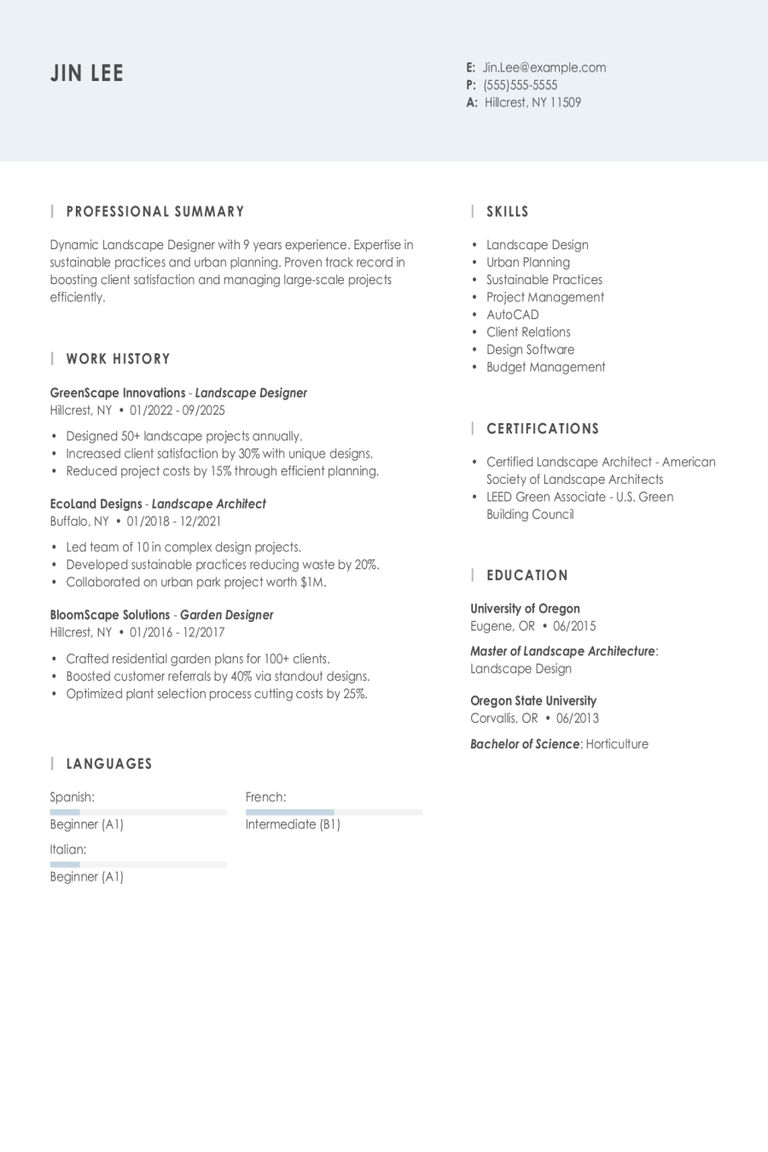
Landscape Designer Resume Examples & Templates for 2025
Browse landscape designer resume examples that show how to highlight your creativity, project planning, and plant knowledge. Learn to showcase your design skills and experience in making outdoor spaces beautiful

Interior Designer Resume Examples & Templates for 2025
Explore interior designer resume examples to see how to showcase your creativity and project management skills effectively. These examples and tips will help you highlight your design experience and unique
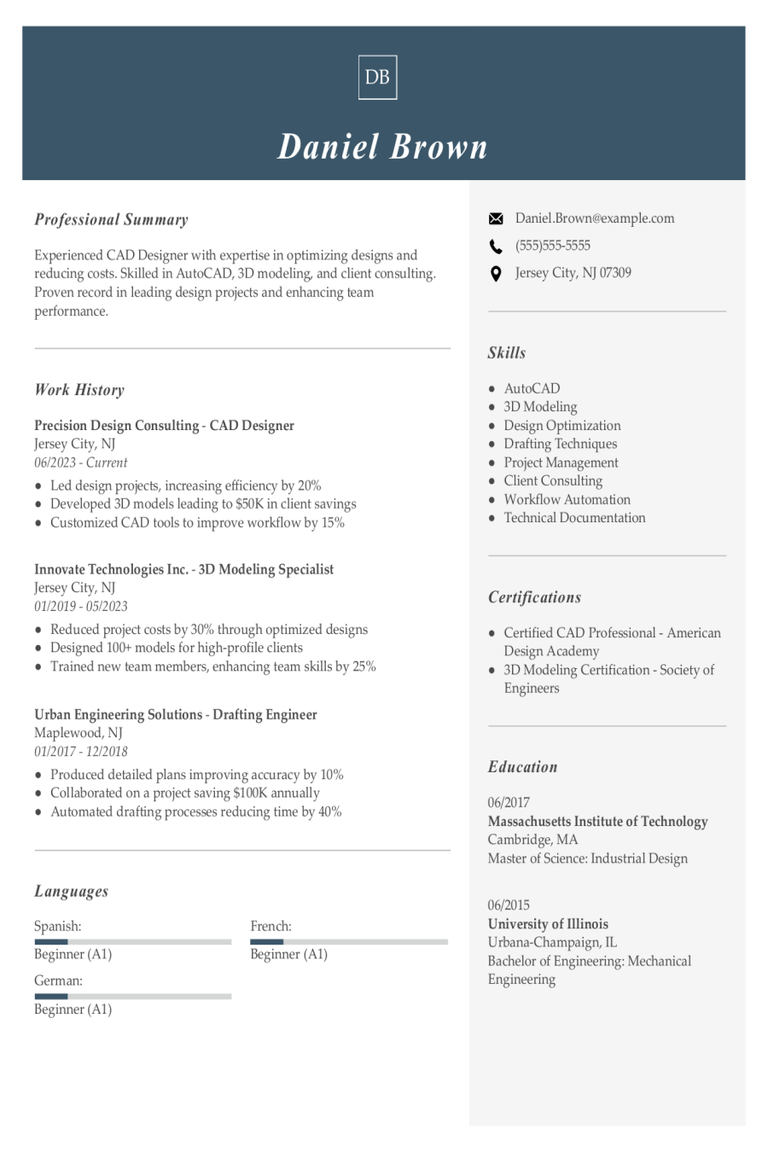
CAD Designer Resume Examples & Templates for 2025
Discover how to craft a standout CAD designer resume with our samples and tips. Learn to showcase your design skills, software knowledge, and project experience to catch the attention of
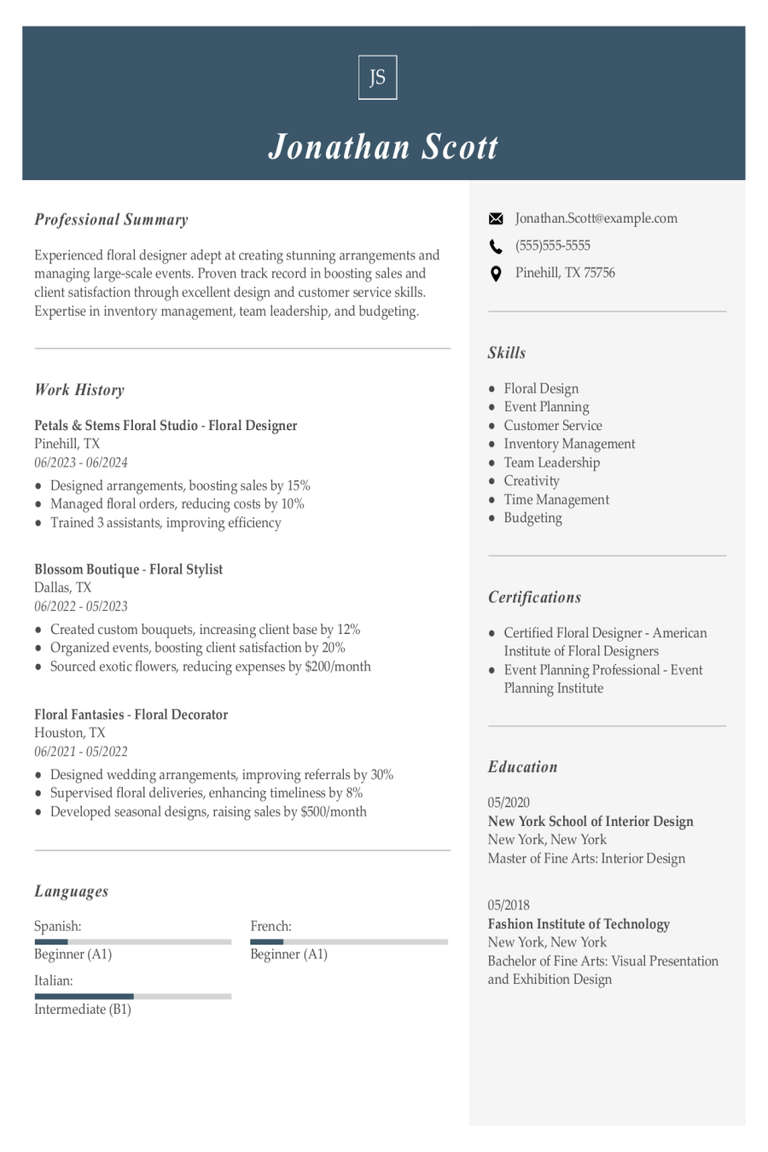
Floral Designer Resume Examples & Templates for 2025
Discover how floral designers showcase creativity and design skills in their resumes. Use these examples and tips to learn how to highlight your floral arrangement, customer service, and event planning
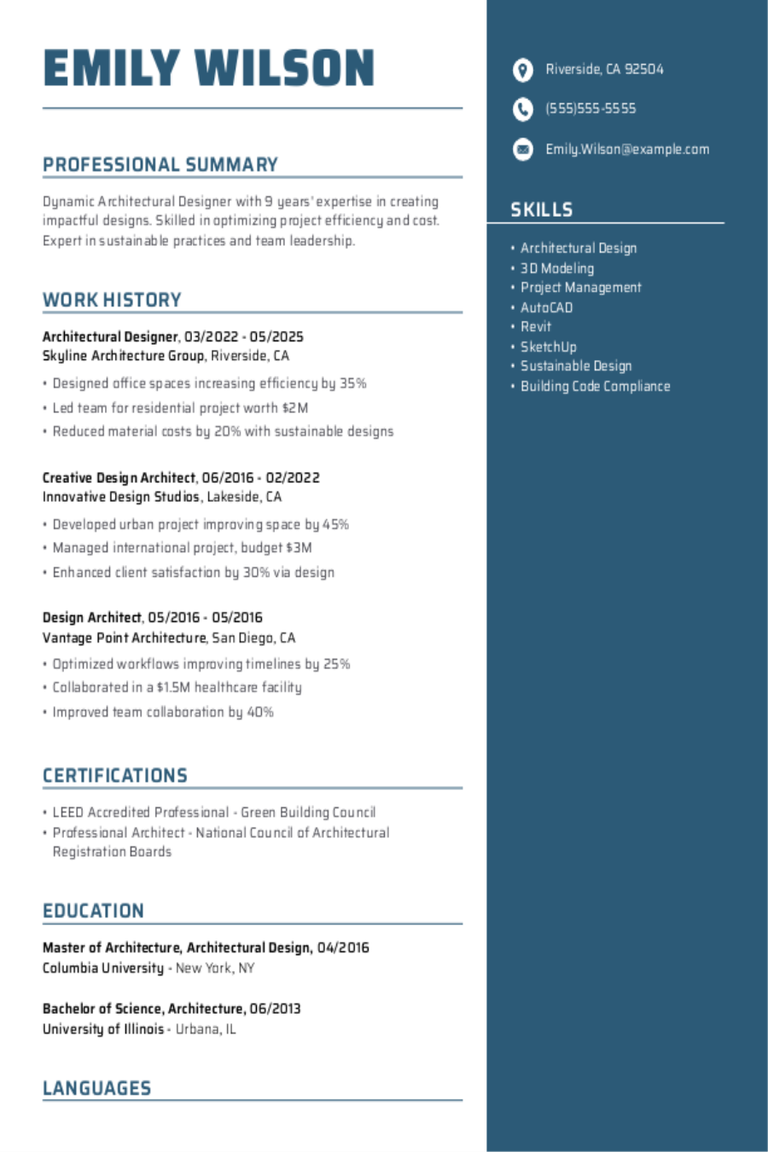
Architectural Designer Resume Examples & Templates for 2025
Explore architectural designer resume examples that show how to highlight your creativity, technical skills, and experience with design software.Build my resumeImport existing resumeCustomize this templateWhy this resume worksQuantifies accomplishments: The applicant’s
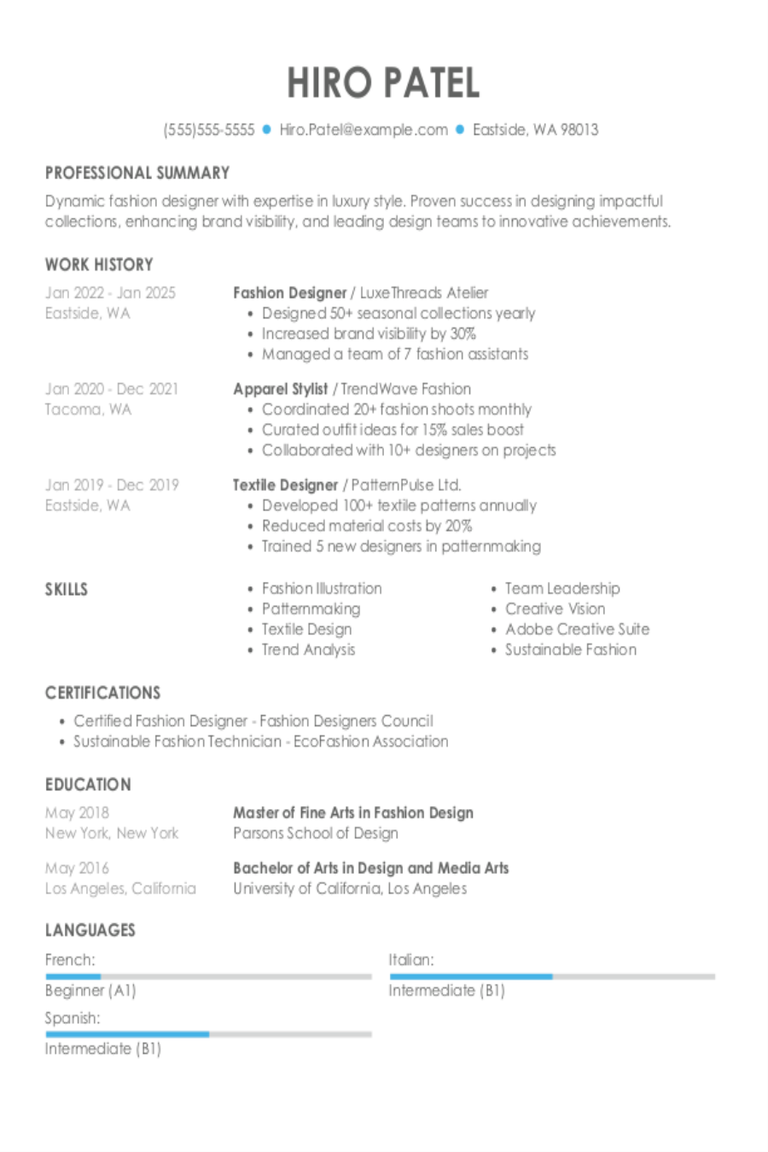
Fashion Designer Resume Examples & Templates for 2025
Discover fashion designer resume examples that show how to highlight your creativity, sketching skills, and knowledge of fabrics. Learn to showcase your design experience and make your fashion ideas stand
